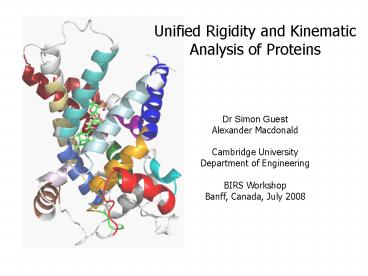Unified Rigidity and Kinematic Analysis of Proteins - PowerPoint PPT Presentation
1 / 27
Title:
Unified Rigidity and Kinematic Analysis of Proteins
Description:
Consider a first-order Taylor Series expansion of the constraint equations about ... Can be optimised to reduce steric clashes and/or take account of dihedral angles ... – PowerPoint PPT presentation
Number of Views:56
Avg rating:3.0/5.0
Title: Unified Rigidity and Kinematic Analysis of Proteins
1
Unified Rigidity and Kinematic Analysis of
Proteins Dr Simon Guest Alexander
Macdonald Cambridge University Department of
Engineering BIRS Workshop Banff, Canada, July
2008
2
Outline
- Rigidity Analysis
- Kinematic Analysis
- Normal Mode Analysis
- ADP/ATP Translocator
3
Rigidity Analysis Consider a first-order Taylor
Series expansion of the constraint equations
about a solution point Solutions of
provide first-order infinitesimal
motions We can use these solutions to undertake
a rigid region decomposition and to identify
possible motions of the protein chain.
4
- Constraints
- Length Constraints
- 2. Angular Constraints
- Planarity Constraints
dihedrals have no stiffness
a
c
b
Jacobian, J, contains the first-order partial
derivatives of the constraint equations with
respect to their generalised coordinates
5
Rigid Region Decomposition Nullspace of the
Jacobian contains infinitesimal
motions (Left-nullspace contains systems of self
stress could be used to identify regions that
are overconstrained and states of self stress
that stiffen certain motions) Methods for
computing the nullspace Singular value
decomposition - Very computationally
demanding - Computes all eigenvectors
(superfluous information) Eigenvalue
analysis - Find all eigenvectors with zero
stiffness QR decomposition - Can calculate a
whole nullspace basis or ensure that all
dependent variables are non-zero in the
solution
6
Rigid Region Decomposition Nullspace contains
linearised motions Apply linearised translation
and rotation operators to return a peptide to its
original position. Check to see what other
peptides also return to their original position,
hence defining a larger rigid cluster.
Original
rigid cluster
Overlap
Displaced
7
Rigidity analysis results are identical to FIRST
PDB code 1K6U Pancreatic Trypsin Inhibitor
PDB code 1GB1 Immunoglobulin binding protein
8
Kinematic Analysis The size of the system
should be much more manageable once the rigid
region decomposition has been undertaken Iterati
ve scheme finds larger motions System is not
determinate so use least squares in correcting
the errors in the non-linear constraint
equations Large computational demand in
calculating the pseudoinverse. Approximation
can be calculated as but still
computationally demanding
9
Kinematic Analysis Matrix method may provide
an improvement to FRODA in that infinitesimal
motions are directly outputted from the Jacobian
nullspace Can be optimised to reduce steric
clashes and/or take account of dihedral
angles Analysis can be driven by probabilistic
roadmap methods (if we know start/end
configurations) or using a Monte-Carlo
method
10
Kinematic Analysis
20 residues, 5000 iterations
11
Normal Mode Analysis
A first-order stiffness matrix can also be
calculated from J G contains scalar
stiffness parameters across the main
diagonal. Allowable dihedrals are now given a
small stiffness No attempt was made to
properly scale bond, angular and planar
stiffnesses Stiffness matrix eigenvectors are
the normal modes of the protein
12
Alpha-Helix Normal Modes
Degenerate bend mode
Torsional mode
Good correlation with principal component
analysis and online normal mode generator, ElNémo
13
Beta-Sheet Normal Modes
Twist mode
Bending mode
Good correlation with principal component
analysis and online normal mode generator, ElNémo
14
ADP/ATP Translocase across the Inner
Mitochondrial Membrane
15
Transporter Details
16
(No Transcript)
17
Transporter Details
Monomeric transporter - probably Antiporter is
comprised of 3 repeated domains of about 100
residues Repeats are composed of two
transmembrane helices and a third smaller
intermembrane helix
18
Repeating Units
19
Transporter Details
Monomeric transporter - probably Antiporter is
comprised of 3 repeated domains of about 100
residues Repeats are composed of two
transmembrane helices and a third smaller
intermembrane helix Stoichiometry One ADP
molecule in / One ATP molecule out System can
be inhibited using atractyloside (ATR)
carboxyatractyloside (CATR) Large positive
charge in the centre of the cavity
20
Electrostatic Potential Surface
view from intermembrane space
view from inner membrane
view from matrix
21
Transporter Details
Monomeric transporter - probably Antiporter is
comprised of 3 repeated domains of about 100
residues Repeats are composed of two
transmembrane helices and a third smaller
intermembrane helix Stoichiometry One ADP
molecule in / One ATP molecule out System can
be inhibited using atractyloside (ATR)
carboxyatractyloside (CATR) Large positive
charge in the centre of the cavity ATP synthase
if driven by a proton gradient, therefore the
antiporter cannot leak protons. Is the
positively charged cavity enough to prevent
proton flow? Helices are not particularly
hydrophobic, especially helix 2 Conformation
change triggers a salt-bridge rearrangement
22
Salt Bridge Network
Odd numbered helices contain the
sequence Proline X Aspartic/Glutamic Acid
X X Arginine/Lysine
23
FIRST
24
Matrix Method
25
FIRST
26
Matrix Method
27
Temperature Factors































